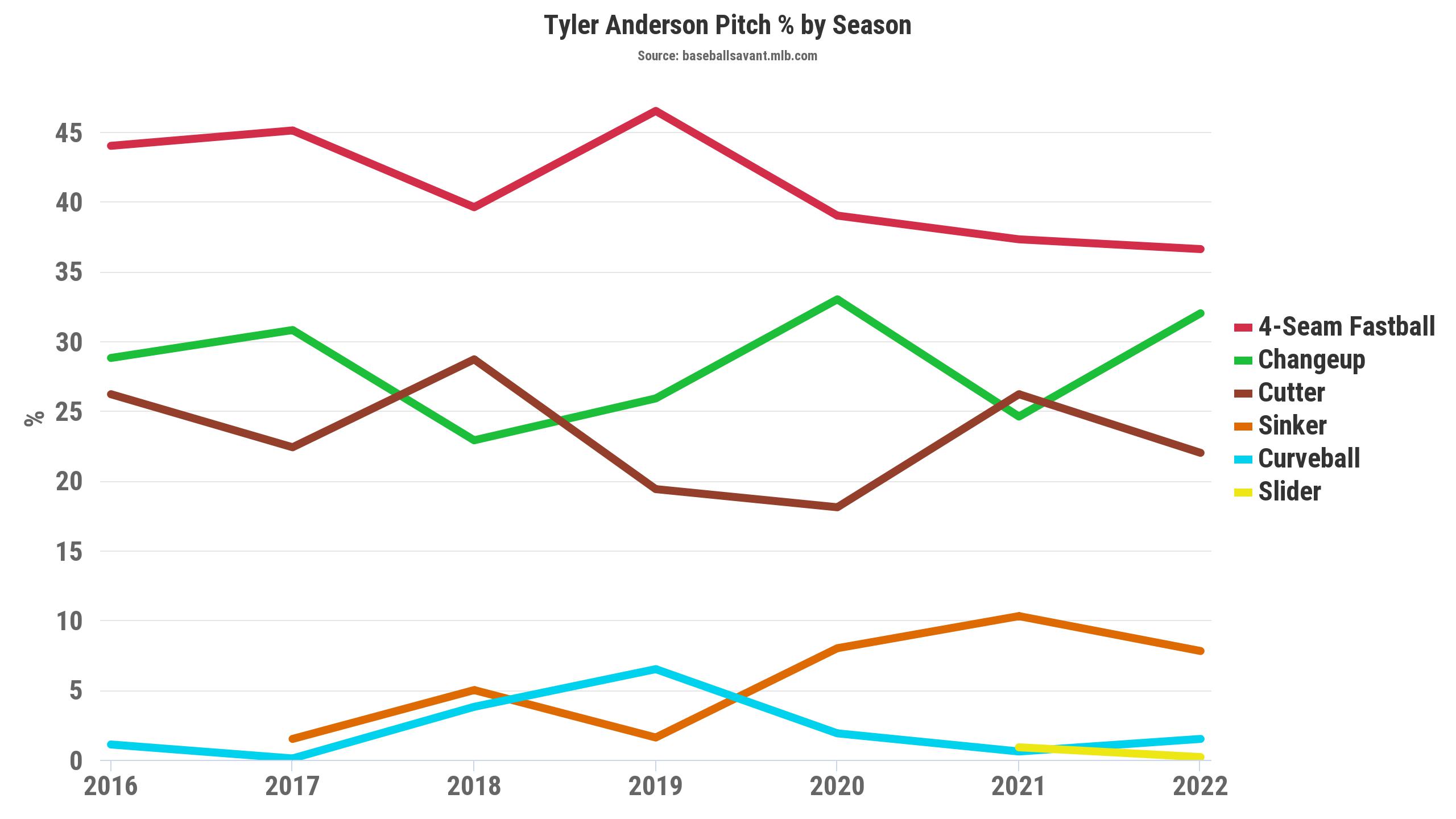Out of Nowhere
At 32 years of age, Tyler Anderson is having the best season of his MLB career by a wide margin. Originally drafted by the Twins in 2008, and then again by the Rockies in 2011, the 6’2″ lefty made his debut with Colorado in 2016. He threw 114 innings, finishing the campaign with a 3.54 ERA with a 99-28 strikeout to walk ratio. To date, that is the only season where Anderson finished the year with an ERA below his career mark of 4.31. And this is not a tale of a pitcher getting unlucky for years and finally seeing some positive regression. Anderson’s FIP for those seasons is nearly identical to his actual ERA.
2019 is excluded as it only covers 20 innings. FIP is of course not the end all be all of pitching metrics, but it has been so well aligned with Anderson’s performance over the past seven years that it is definitely valuable information in his case. In fact, I’ve never seen FIP match up this well versus any pitcher’s observed ERA. Aside from just being interesting though, Anderson’s long-standing FIP/ERA relationship suggests that he might be due for some, but not a worrying amount of regression.
But before we jump into whether Anderson can continue to carry a sub 3.00 ERA, we need to understand how he’s doing it. Why is he suddenly such a better pitcher than he has been for over half a decade?
It’s tempting to handwave some of Anderson’s early career ERAs in the 4.50 range as a product of him pitching at Coors Field, one of the offense-friendliest parks in the league. But, as illustrated in the chart below, the thin air of Colorado was not to blame.
Anderson was in fact way better at home than on the road during his tenure with the Rockies. To drive home the point even further, Anderson’s performances for the Giants in 2020 and the Pirates and Mariners in 2021 look almost identical to his stats in Colorado, despite those teams having home parks that tend to favor pitchers.
So then, what changed for Tyler Anderson this season? A quick look at some of his ratios illustrates that he is allowing fewer baserunners than ever before.
Oh my! That is stingy. Anderson is allowing almost 1.5 fewer hits per nine innings (think roughly one fewer hit every six innings), and nearly one less walk per nine innings than he’s averaged over his career. Those numbers combine to give Anderson a WHIP that is about 20% lower this season than his career WHIP, and he’s cut his home run rate nearly in half. The only area where he has not improved is his strikeout rate, but he was never a big K guy to begin with, having only managed to break the one strikeout per inning mark once, during his 2019 season, which we’ve been rightfully ignoring since it only represents twenty innings.
So those are excellent ratios that strongly support Anderson’s performance so far this season. And he’s doing it mostly relying on the same mix of pitches he’s used in the past.

Anderson is throwing his four-seamer, an underwhelming offering that generally sits around 90-91 mph, at the lowest rate of his career, but only a few percent less often than he has over the previous two seasons. He’s using his sinker a bit less than he did last season, but not by a significant amount. The biggest difference is that Anderson is going to his changeup on nearly a third of his pitches, just a bit less often than his four-seamer. He’s also throwing it with less velocity than he has over the past couple seasons, averaging around 79 mph on the offering while he sat around 81 mph over the 2020 and 2021 seasons. More importantly, Anderson is getting more vertical movement on his change and is getting fabulous results from the off-speed offering.
Gaining a solid eight inches of vertical movement over two seasons is a great way to turn what was a mostly average pitch into a league beater. Those batting average and slugging percentage numbers both rank third in the league among pitchers with at least 100 PA. Even better, that -14 in run value paces all of Major League Baseball, narrowly beating out Sandy Alcantara’s changeup. Doing anything better than Sandy Alcantara in 2022 is quite the feat.
Approaching the three-quarter mark of the season, Anderson ranks in the top ten percent of pitchers in average exit velocity allowed, hard hit percentage, and walk rate. He’s been excellent at limiting hard contact and making hitters work to get on base. Anderson does allow fly balls and line drives at rates just barely above average so it’s possible that there may some regression on his fantastic HR rate, but with all that soft contact and his stinginess with walks, major regression appears unlikely. He also pitches for the best team in baseball and has failed to pitch at least six innings in just four out of eighteen starts since May 1, making wins and quality starts easy to come by.
I’ve chosen Anderson at every opportunity when playing “who would you rather” on the always entertaining This Week in Fantasy Baseball podcast, but the trade deadline has passed in most leagues now, so you probably can’t acquire Tyler Anderson at this point (and if he’s available on waivers, find a better league). So if he’s on your roster, go ahead and pat yourself on the back for making one of the better fantasy baseball decisions of the year. In an age of fireballers and 96 mph changeups, Tyler Anderson, thanks in large part to an elite changeup, is dominating with one of the least overpowering arsenals in the majors. He really is killing it softly.
Featured image by Michael Packard (@CollectingPack on Twitter)

